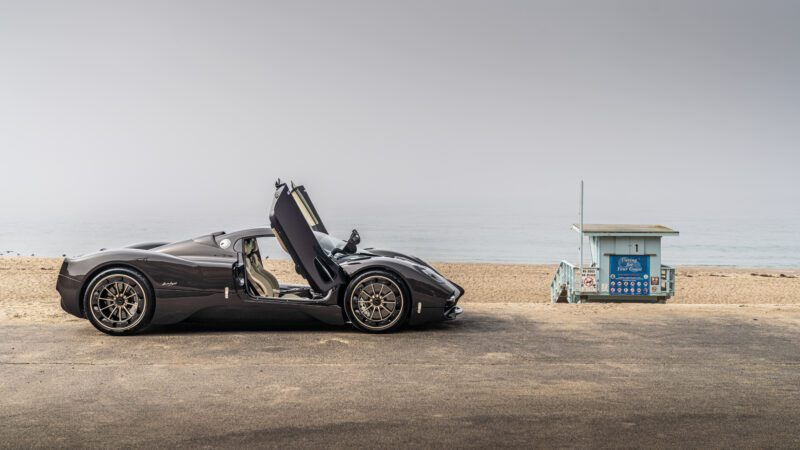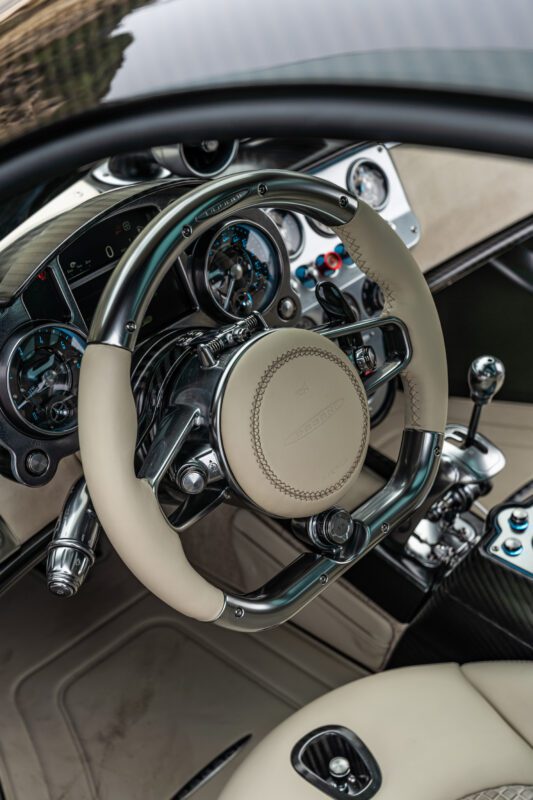What is a multi-million dollar experience? Although still integral, performance is no longer the sole driving focus of a car whose price sports two commas. EVs have long distilled the extreme into the mundane, and this democratization of speed has created a rift in the industry’s upper echelons.
Earlier this year, as I walked the lawns of The Quail, A Motorsports Gathering, I could see the shift happening in real-time. For the most part, the million-horsepower EVs were absent, with every manner of seven-figure restomod littering the space. Bugatti unveiled the Tourbillon and its 9,500-rpm naturally-aspirated V16, while RUF entered the off-road scene with the Rodeo. It became clear that buyers in this niche within a niche aren’t looking to be impressed; they want to feel something.

Yet even on Mount Olympus, the Pagani Utopia Roadster proved to be Zeus. Its silk cover fell surrounded by one of the largest crowds I’ve ever seen at this show. For a car of which just 130 units will exist, thousands turned up for a glimpse of the open-top two-seater. Even as the day wore on, seeing it in its entirety proved challenging amongst a sea of sport coats and big hats. At that moment, I understood its draw: even if you have never driven or owned one, seeing its striking design and extreme proportions is experience enough.
It’s been a few months and I’m standing in a showroom at Pagani of Beverly Hills. A Huayra R sits just behind the front glass, its massive footprint taking much of the floor plan. Behind it, almost hidden behind its wing, sits a Pagani Utopia Coupe. It’s rarer than the Roadster in Monterey, given its planned 99-car production run, and unlike the car I had to fight to catch a glimpse of, this one I’m driving.

The invitation to the driver’s seat comes a few hundred feet off the Pacific Coast Highway in Santa Monica. I slip my finger under the latch, a silver sliver that punctures through the exposed carbon panel. It clicks, and the door juts out and upwards. Made up of lightweight fibers, aluminum, leather, and glass, it’s likely worth six figures on its own.
In most cars, opening a door and jumping in would be, at best, a forgettable experience. Pull the handle, mind the door sill, and settle in. Job done. However, the Pagani Utopia isn’t satisfied with that. From the aluminum that’s cold to the touch to the mechanical sound it makes as you lift, down to the perfectly aligned weave that glistens as the large panel swings out, the Utopia rebukes the conventional.

Inside, it’s as analog as it is beautiful. Every control is a switch, a lever, or a button, each requiring considerable force to engage. Pagani mills its wheel out of a single piece of aluminum, with its hub, rim, and spokes all existing as one component. Two shift paddles with an exposed carbon finish sit just ahead, creating textural contrast against the aluminum and leather-wrapped wheel.
In contrast to the Huayra, the Utopia offers a choice of two transmissions, the first being a seven-speed manual or an automated version like the one fitted to this car. According to Pagani, most customers have opted for the manual. A feat in itself, considering the Italian marque had to develop numerous in-house components to support the power and torque produced by this car’s twin-turbocharged V12.
A large red button in its center console, at least double the size of any other, sets the engine ablaze. It snarls as it comes to life, then settles to a hum. Setting off requires a firm brake pedal press, its pedals floor-hinged like on a 60s Ferrari, and a strong pull of the gear lever to engage first gear. Its exposed linkage tilts until it clicks. Given the required effort, you must commit to every action. Every shift, flick of a switch, or press of a button has to be intentional.

The Pagani Utopia doesn’t rely on countless screens to exhibit information, just a single display between its analog gauges. It’s necessary to show drive mode and active vehicle information. Still, its graphics employ a sober palette to not distract from the rest of the cabin. The row of dials in the center console, whose faces are cut out like a sandwich-dial watch, display vital information at a glance. There’s never a need to sort through a menu. There’s nothing to distract you from the present.
The first few miles heading north on the PCH go by in a crawl. G-Wagons and Range Rovers destined for Malibu clog the lanes, the Utopia’s broad shoulders just about wholly filling the space between the lines. For a car whose cabin tapers in a teardrop shape, it’s never claustrophobic. Thanks to six pieces of glass, three on the roof, natural light floods the interior. As you look ahead, you see the tops of the fenders rising like mountains, almost to eye level, while peering through the top-hinged side-view mirror reveals the rears standing taller still.

Its sensory overload, which combined with the mix of materials used in the interior along with the level of force required to interact with it, grounds you in the experience. For the time being, the only thing you can do, the only thing you’re allowed space to think about, is this car.
As I climb the canyon with the ocean now to my back, I can finally start to explore its tachometer and pick up the pace. Like the Zonda and the Huayra, the Pagani Utopia turns to Mercedes-AMG for its heart. Yet despite its Affalterbach origins, AMG developed this 6.0-liter twin-turbocharged V12 specifically for Pagani.

The figures are, as you’d expect, monumental. Doubly so once you consider that despite the abundance of plug-in hybrids in the seven-figure space, the Utopia does not incorporate any form of electrification. It develops 864 horsepower and 811 pound-feet of torque. Its peak torque output runs from 2800-5900 rpm, a significant spread considering its V12 maxes out at 6700 rpm.
The exhaust noise isn’t what first strikes you as you begin to link corners, repeatedly coming on and off the throttle; it’s the constant wooshing of turbochargers. It’s like having hurricane winds contained just behind your head. Its ceramic-coated titanium exhaust underscores it with a note harmonized by equal-length headers. It’s distinct. It is not quite as high-pitched as a higher-revving twelve, but it produces a more guttural note with plenty of bass.

Despite having a relatively narrow rev range, there’s plenty of character throughout. It picks up slowly at first as its turbos begin to spool. However, as the wooshing intensifies almost to a whistle, you’re hit with explosive torque, not losing steam even as you approach redline. Pull the right paddle or the central lever, and the experience only intensifies. If the kick from the engine doesn’t get you, the shove from its transmission certainly will.
Its automated-seven speed moves through gears with the grace of a sucker punch. Although the manual option has thus far proven more popular, there’s nothing dull about this two-pedal car. If the Pagani Utopia was concerned purely with performance, you could criticize it for not shifting lightning fast like a dual-clutch box or not nearly as smooth. However, that’s not what this car is about.

Even if you set aside the weight savings benefits of a single versus a dual-clutch configuration, this transmission is still the best match for this car’s core philosophy. Its dramatic shift stops your mind from wandering as if to grab you by the shoulders and shake you awake from a daydream. The Utopia demands your full attention. It will accept nothing less.
Like its many levers and switches, the Utopia’s brakes require substantial inputs. At slower speeds, it can be challenging to come to a smooth stop, with the last bit of deceleration happening all at once. However, as the pace elevates, the added firmness of the pedal makes modulating it intuitive. This Pagani’s carbon ceramics sit nestled behind a staggered set of 21 and 22-inch wheels, available with or without Aeroblade Carbon Deflectors. This pre-production car wears both styles.

Given what you’ve learned thus far, you can guess what its steering is like. But you’d be wrong. Although the Utopia’s wheel is nicely weighted, there’s a delicacy to it that you wouldn’t expect. It’s quick and precise while still managing to be incredibly communicative. You can feel it feeding information from the road through your fingertips and into your nervous system. There’s a sense of connectedness to this car that further entrenches you in its driving experience.
Its carbon structure plays a significant role in achieving this. The Utopia’s shell itself is made of a combination of Carbo-Titanium and Carbo-Triax. Once you step back to consider the whole car, over 40 variations of carbon fiber are used to build it. The result is a dry weight of 2,822 lb, or 154 lb less than the Huayra. However, while this material’s lightness gets the most press, its rigidity is just as significant.

Despite the Pagani Utopia not leaning on an overly stiff suspension setup, incorporating four double wishbones and adaptive dampers, it manages to translate plenty of feedback through the carbon monocoque. And because of its featherweight status, you have a comfortable car for longer drives without sacrificing on-road feedback or driver involvement.
This is ultimately how the Pagani Utopia answers the question posed initially. A multi-million dollar experience is emotional, immersive, and exciting. Yet the Italian marque doesn’t lean primarily on performance to achieve this. You can’t just mindlessly jump in and drive the Utopia. Every control, down to the most minor button, requires careful consideration. Whether you anticipate it or not, it shifts your state of mind.

You’re further centered in the moment once you sit in and look out its many glass windows. You begin to feel like you’re about to do something special. It’s a feeling that spreads as you hear its wooshing turbos or feel the road below through your fingertips. The Utopia is a sensory experience like no other I’ve experienced.
It’s made all the more special by its rarity. Priced at $2.5 million to start, Pagani will build 99 Coupe’s and 130 Roadster’s with the latter commanding an elevated price.
What I saw as I walked the lawn at the The Quail was undoubtedly a shift. A view of an industry redirecting its priorities away from superfluous numbers in pursuit of creating truly memorable and thrilling experiences. All minus one because, as the Utopia proves, Pagani has already mastered the art.











